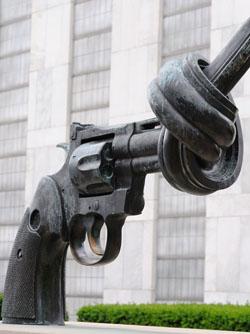Bridging the Gap
Canada's Confederation on July 1, 1867 brought four eastern provinces together to form a new and unified country. To secure their admission, the provinces of Nova Scotia and New Brunswick were assured that a railway linking them with the two Central Canadian provinces—Quebec and Ontario—would be provided.
Manitoba, the province directly to the west of Ontario, joined the Confederation later in 1870. British Columbia on the faraway west coast was persuaded and enticed to join the fledgling Confederation in 1871, but only with the clear promise that a transcontinental railway would be built within ten years to physically link east and west. A nation-building effort from coast to coast was in the making.
Within four years of Confederation, the nation of Canada, which then had a population well below four million people, determined that it would build the world's longest railroad across "empty"—unexplored and relatively unpopulated—country. As in most bold ventures, not all were in agreement. In fact, many considered the plan brash to the point of recklessness. Some even referred to it as "insane recklessness."
So in the 1870s, Canadians of all stripes—politicians and journalists, contractors, bankers, surveyors and the average working man—either fought for the railway, or were dead set against it. Would this national dream prove to be a nightmare?
A National Dream
The railway's early construction was marked by controversy. That controversy would eventually topple the Conservative government of Canada's first Prime Minister, John A. Macdonald, forcing an election in 1873. By the time Macdonald did return to power in 1878 the project was seriously behind schedule and in jeopardy of never being completed. However, all was not lost, when finally a group of businessmen formed a syndicate determined to complete this national dream.
The following history from the Canadian Pacific Web site should enlighten us on the matter: "In October 21, 1880 a group of Scottish Canadian businessmen finally formed a viable syndicate to build a transcontinental railway. The Canadian Pacific Railway Company was incorporated February 16, 1881, with George Stephen as its first president.
"The 1881 construction season was a bust and the railway's chief engineer and general superintendent were fired at the end of the season after building only 211 km (131 miles) of track. Syndicate member and director James Jerome Hill suggested William Cornelius Van Horne was the man who could get the job done.
"Canadian Pacific Railway was founded in 1881 to link Canada's populated centres with the vast potential of its relatively unpopulated West. This incredible engineering feat was completed on November 7, 1885—six years ahead of schedule—when the last spike was driven at Craigellachie, B.C." ("Our History," Canadian Pacific, www.cpr.ca, 2015).
Finally, on November 7, 1885, the eastern and western portions of the Canadian Pacific Railway were connected when a man by the name of Donald A. Smith drove the "last spike."
The decision to proceed despite relentless and at times fierce opposition would turn out to be the right one for the country, a decision that was destined to change the lives of every man, woman and child in Canada and alter the shape of the nation. It would be a physical bridging of the gap, and would knit together a vast country, bringing people readily together and overcoming the great natural barriers of Canada's wilderness.
But other barriers remain to this day.
A Dream for the Future
In this world, there are many things that divide nations and peoples, and many of them are greater even than geographical barriers like seas, mountains and great expanses of land. Religion, cultural differences, political persuasions and national agendas often drive humans and nations away from the hope of true unity.
The building of a railway system, although beneficial in many ways, does not provide the way to achieve true peace and unity among nations, or even within the borders of one nation. Mankind, in its desire for togetherness and the prevention of war, has set up world organizations like the United Nations, and its predecessor the League of Nations, for the purpose of maintaining unity and peace among nations. And today we even hear about the desire to have "One World Government."
However, can mankind—which has difficulty even building a railway from coast to coast—ever hope to achieve that one-world government and the unification of all nations? History has repeatedly shown mankind's inability to do so.
God's word does speak of that actually occurring; not by the methods and ideas of flawed human beings, but under the direct rulership of Jesus Christ—through a "one-world government" which your Bible calls the Kingdom of God. The returned Jesus Christ will bring about unity and bridge the gap between nations and peoples.
How will this be done?
Isaiah 11:9 tells us how: "They shall not hurt nor destroy in all My holy mountain, for the earth shall be full of the knowledge of the Lord as the waters cover the sea." God's laws, when properly followed and obeyed, will be the means by which unity will be achieved and mankind's fondest hopes and dreams fulfilled: "For unto us a Child is born, unto us a Son is given; and the government will be upon His shoulder. And His name will be called Wonderful, Counselor, Mighty God, Everlasting Father, Prince of Peace. Of the increase of His government and peace there will be no end, upon the throne of David and over His kingdom, to order it and establish it with judgment and justice from that time forward, even forever. The zeal of the Lord of hosts will perform this" (Isaiah 9:6–7).
God is determined to bring about world peace and the unity of nations His way—which is the very best way, as the world will surely see. Isaiah 19:23–25 describes a sampling of togetherness and unity, and a bridging of the gap that will be achieved during the reign of the King of kings: "In that day there will be a highway out of Egypt to Assyria, and the Assyrian will come into Egypt and the Egyptian into Assyria, and the Egyptians will serve with the Assyrians. In that day Israel will be one of three with Egypt and Assyria—a blessing in the midst of the land, whom the Lord of hosts shall bless, saying, 'Blessed is Egypt My people, and Assyria the work of My hands, and Israel My inheritance.'"
At that time, the peoples of this world will experience much more than a "national dream" fulfilled through physical means. They will finally experience the reality of true peace and harmony—and the end of all strife and competition among nations, when Jesus Christ returns to set up His world-ruling government.
This is why Christ instructs us to pray daily, "Thy Kingdom Come."






